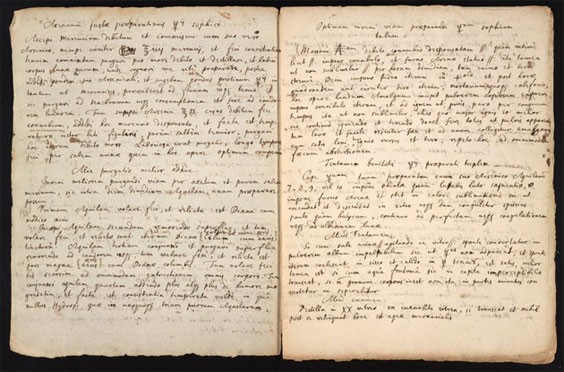By Ana Verayo, | April 10, 2016

In this manuscript, Newton included the recipe for sophick mercury which is a key ingredient in the philosopher's stone.
Sir Isaac Newton's famed 17th century manuscript detailing his important historical works is now revealed online, after being held in a private collection for decades.
Like Us on Facebook
This document that resurfaced is apparently a copy of a manuscript made by alchemist George Starkey that details the preparation of a substance known as "sophick mercury" which is an essential ingredient in the legendary "philospher's stone" that can transform any base metal into gold.
This precious manuscript was recently bought a nonprofit group, Chemical Heritage Foundation that is based in Philadelphia last February where they are now releasing digital images from this manuscript along with its transcriptions of the text into an online database for further study. The manuscript is written in both Latin and English.
According to James Voelkel from the Othmer Library of Chemical History, the significance of this manuscript is offering never before seen information and insights about Newton's alchemical readings of his favorite author which also gives us more direct evidence of this mysterious and controversial laboratory procedure.
Voelkel also reveals that there are a multitude of Starkey's alchemical manuscripts which Newton wrote an estimated 1,000,000 words of notes regarding that alchemy which were produced in his lifetime. He says that this particular manuscript is also one of these.
Starkey published a sophick preparation in 1678 in Latin where he goes by the name Eirenaeus Philalethes. This manuscript of Newton is also a copy of another Starkey manuscript, which is not the printed text, that could possibly predate this published version. Voelkel explains that Newton's comments were in square brackets which expanded the abbreviations on the other manuscript or even correct it.
Apart from this, Newton also even wrote about the distillation process of iron ore on the back of this manuscript which is found to be unrelated to sophick, which is also bought by the Chemical Heritage Foundation. Voelkel reveals that this could possibly be laboratory notes of a process that Newton experiments or was planning to do so, where he would just write at the back of the manuscript, on the blank page.
Voelkel who is also from the Beckman Center for the History of Chemistry says that Newton's terms about alchemy and chemistry were basically related to Newton's time.
-
Use of Coronavirus Pandemic Drones Raises Privacy Concerns: Drones Spread Fear, Local Officials Say

-
Coronavirus Hampers The Delivery Of Lockheed Martin F-35 Stealth Fighters For 2020

-
Instagram Speeds Up Plans to Add Account Memorialization Feature Due to COVID-19 Deaths

-
NASA: Perseverance Plans to Bring 'Mars Rock' to Earth in 2031

-
600 Dead And 3,000 In The Hospital as Iranians Believed Drinking High-Concentrations of Alcohol Can Cure The Coronavirus

-
600 Dead And 3,000 In The Hospital as Iranians Believed Drinking High-Concentrations of Alcohol Can Cure The Coronavirus

-
COVID-19: Doctors, Nurses Use Virtual Reality to Learn New Skills in Treating Coronavirus Patients







